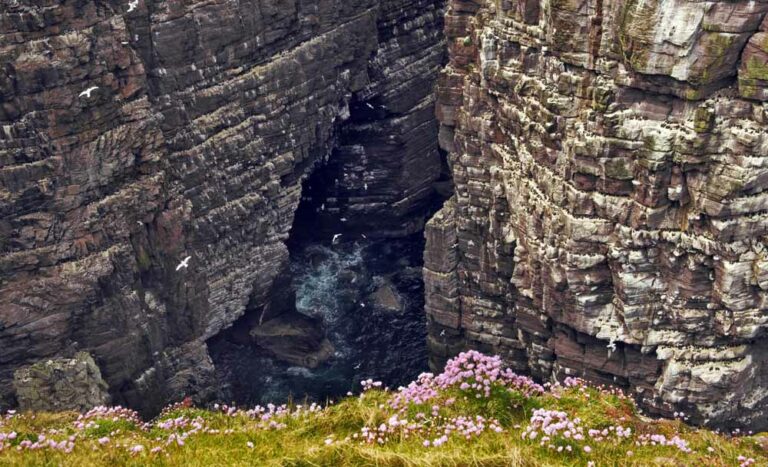Handa Island,
Sutherland.
(Written 18th May 2019)
I don’t quite know how it happened, but this afternoon I fell asleep at the edge of a sea cliff, hundreds of feet above the Atlantic, amidst the cacophony of a seabird colony at the peak of the nesting season. Handa Island, a nature reserve managed by the Scottish Wildlife Trust in the far north west of Scotland, is home in the summer months to nearly 100,000 seabirds including guillemots, fulmars, razorbills, kittiwakes and puffins, concentrated on dramatic Torridonian sandstone cliffs rising from the Atlantic on the island’s north western edge.
The narrow ledges of the cliffs form a library of seabird life on a massive scale, crammed with birds angled into the shelter of the white-stained rock. The air screams with the chittering and bickering of thousands of birds jostling for space. Around the cliffs and out to sea, the activity of the colony is a wild display of flying confetti, as the birds fly to and from their nest sites on urgent feeding forays.
An imposing sea stack, the Great Stack of Handa, 300 feet high, sits apart from the main island with its own density of seabirds, like an enormous, overcrowded tower. The seabird activity here is so concentrated, that the eye is instantly propelled into the vortex of a breeding frenzy. The amount of birdlife stapled into every possible crevice, nook and cranny, forming densely packed lines of nesting birds and chicks, all crammed together like columns of narrowly spaced text, is simply mind-blowing. It feels like peering into the cross section of a beehive. The senses are assaulted by the sheer number of birds, the mayhem of their flight paths, the sound of their cries rising up above the Atlantic swell, and the pungent smell of guano plastering the cliffs from top to bottom.
The handful of visitors that landed on the island with me had moved on, following the path that circumnavigates the island. I lingered to have some time on my own, without the distraction of people and conversation close by. I nestled down on a prolific cushion of sea pinks forming a perfect hollow at the cliff edge, warmed by the afternoon sunshine and out of the wind. Closing my eyes, I could hear the clamouring sound of the colony, rising and falling from the vertical drop below me, mixed with the background wash of the sea, surging at the base of the cliffs and lulling me with its incessant churning.
I felt deeply comforted by the audible presence of so much birdlife close by, and I let the wall of wild sound wash over me. I must have dozed off for about twenty minutes. When I woke up, the sound hit me afresh, like an orchestra crashing directly into my conscious awareness and pouring through me, at the same intensity as before, as if no time had passed and nothing had happened apart from a fleeting disconnection with the soundscape of the moment. It was like a switch flicking back on, as if I had become hardwired to the wheeling, clamouring cries rising up from the cliffs below and filling the salty air.
For a few suspended moments, I allowed myself to simply revel in the proximity of thousands of wheeling birds in the sky above and sounding up from the void below, the enigmatic ebb and flow of a seabird colony in full throttle. Occasionally a puffin dangled in the air nearby, coming in to land with its rainbow-coloured beak stuffed with sand eels, scrabbling for foothold on the cliff edge. Their squat black and white bodies, quizzical clown-like facial expressions, brightly coloured bills and orange webbed feet are impossibly endearing, and I marvelled at how they could parachute so deftly on to the luxuriant turf of their cliff top burrows.
I was gladdened by each one that I saw land. Puffin numbers have declined rapidly in certain areas in recent years due to shrinking sand eel populations caused by warming coastal waters. But here on Handa, they were still breeding in large numbers and their presence on the cliff seemed like a statement of survival. I felt gratitude for the number of birds evident on these sea cliffs this fine May afternoon, and for the resilience this represents in a world of accelerating species decline. The numbers of seabirds overall may be going down, but each bird present on these cliffs is a survivor at a critical time of climate change. Their wondrous and collective presence here, seemed a precious and positive affirmation of life flourishing and going forward in some degree of healthy measure.
I was reluctant to leave, partly so as not to break the spell, but also because of a nagging uncertainty that I would ever see such numbers here again. It was as if the sound and presence of the birds had penetrated beneath my conscious awareness, and had lodged deep in my memory, dropping beneath the mind’s temporary ability to apprehend the magnitude of such a spectacle. But perhaps it was also because the birds had opened me to an experience of being more fully and vividly awake, as if I had lost my sense of centre and periphery and there was now only open space, with the sharpness of the seabirds’ cries and their forms wheeling through the boundlessness of the mind.




